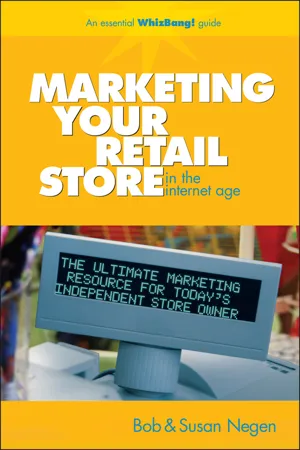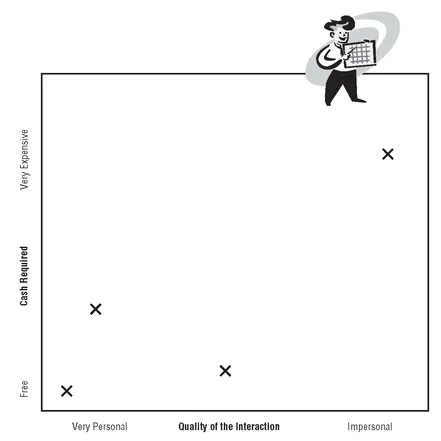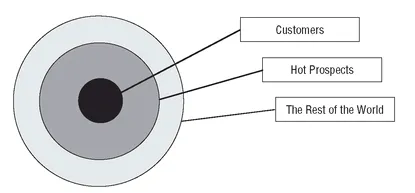
This is a test
- English
- ePUB (mobile friendly)
- Available on iOS & Android
eBook - ePub
Marketing Your Retail Store in the Internet Age
Book details
Book preview
Table of contents
Citations
About This Book
If you own and operate a small retail business, this guide will give you a proven system for marketing your store, allowing you to compete with online merchants and big-box stores alike. Full of fresh and innovative ideas for promoting small stores, it will show you how to create a great in-store experience and build loyal, long-lasting relationships with customers.
Frequently asked questions
At the moment all of our mobile-responsive ePub books are available to download via the app. Most of our PDFs are also available to download and we're working on making the final remaining ones downloadable now. Learn more here.
Both plans give you full access to the library and all of Perlego’s features. The only differences are the price and subscription period: With the annual plan you’ll save around 30% compared to 12 months on the monthly plan.
We are an online textbook subscription service, where you can get access to an entire online library for less than the price of a single book per month. With over 1 million books across 1000+ topics, we’ve got you covered! Learn more here.
Look out for the read-aloud symbol on your next book to see if you can listen to it. The read-aloud tool reads text aloud for you, highlighting the text as it is being read. You can pause it, speed it up and slow it down. Learn more here.
Yes, you can access Marketing Your Retail Store in the Internet Age by Bob Negen, Susan Negen in PDF and/or ePUB format, as well as other popular books in Business & Small Business. We have over one million books available in our catalogue for you to explore.
Information
STEP 1
How to Get New Customers without Going Broke
Five Key Concepts for Getting New Customers
These five basic marketing ideas are important to understand because they are the foundation for all the tactics that follow. In fact, these five concepts will come into play again and again as you go through this book.
Key Concept #1: Be Willing to Pay to Get New Customers
Unless you’re counting strictly on word of mouth or your good looks to bring you business, you’re going to have to pay to generate a steady flow of new customers.
If you buy an ad in the yellow pages, in a coupon pack, or in the local newspaper, you are spending money to acquire new customers. If you send a postcard to hot prospects, the cost of the card and the postage buys you new customers. If you’re paying big bucks for rent at a high-traffic mall, you’re spending money to get new walk-by customers.
Even if you’re banking on your good looks to get you new customers, you’ll probably have to spend on gym membership, tooth whitening, hip hairstyle, and stylish clothes. They’re all costs of acquiring new customers using the good looks tactic!
Here’s an example of how much it’s costing two fictional store owners to buy new customers.
Money Bags Mark
Gets new customers using
regional magazine
advertisements.
Gets new customers using
regional magazine
advertisements.
Cost of Magazine Ad
Ad Design—$250
Cost of Ad—$1,250/month
On average Mark gets three
new customers
from each magazine ad.
Ad Design—$250
Cost of Ad—$1,250/month
On average Mark gets three
new customers
from each magazine ad.
Total Cost to Acquire a New
Customer: $500
Customer: $500
Savvy Sam
Gets new customers using a
referral system.
Gets new customers using a
referral system.
Cost of Referral System
Post card—$.75 per prospect
25% off first purchase—
Avg. $7.50
Thank-you card for referrer—
$1.00
Free gift for referrer—
$5.00 Blockbuster card
Post card—$.75 per prospect
25% off first purchase—
Avg. $7.50
Thank-you card for referrer—
$1.00
Free gift for referrer—
$5.00 Blockbuster card
On average Sam gets one new customer for every 15 postcards sent.
Total Cost to Acquire a New Customer: $51.75
So which business owner is doing the better job of buying new customers? Well, at first glance it sure looks like Savvy Sam has the best strategy (which he probably does), but if the lifetime value of Mark’s customers is $27,000 then spending $500 to get a new one sounds like a great deal to me.
And if the lifetime value of Sam’s customers is only $63, then paying $50 for a new one seems way too steep. Remember the old adage you get what you pay for? Cheapest is not always best. You are sometimes better off spending a little more and getting better customers (those who will spend more and continue to buy from you again and again) than spending less and getting low-quality customers (one-time buyers of your lowest-priced products or services).
The trick, obviously, is to buy the most good quality customers for the least amount of money. Just because you can afford to spend $500 to buy a customer doesn’t mean it’s not better to spend less. And there’s no doubt that most of us can’t afford to spend that much. That’s why the next section of the book is focused on lower-cost, highly targeted ways to acquire new customers.
Check out Figure 1.1. This gives you a visual frame of reference for thinking about your marketing tools.
Everything in the lower left section is low-cost and very personal. For an independent retail store these tactics are most likely to give you the highest ROI (return on investment). The upper right section is most likely to put you in the poorhouse—very expensive and very impersonal.
Take a look at the four Xs and see if you can figure out which one is:
• A billboard.
• A referral.
• A bag stuffer.
• An endorsed mailing (more on this later).
Figure 1.1 Bob’s Marketing Matrix.

You might want to take all your marketing tools and plot them on this grid. Do you have too much expensive, impersonal stuff?
Key Concept #2: Understand the Lifetime Value of a Customer
The “lifetime value” of your customer is the total dollar amount they will spend with you before they take their business somewhere else, move away, or die. Customers are not “one-shot wonders.” They are the lifeblood of your business. A good customer will use your services many times over the course of many years and will refer their friends, family, and business associates to you.
Shortsighted businesspeople like to make the fastest possible dollar in-and-out. Smart businesspeople do everything they can to nurture relationships and increase the lifetime value of their customers.
You may not have the sort of detailed records you need to determine the actual average lifetime value of your customers. Most businesspeople don’t. But that shouldn’t stop you from building long-term, even lifelong relationships with your new customers and perhaps starting to keep track of that information.
Eventually you’ll be able to figure out a dollar amount value that an average customer spends on your services over a period of years. Remember: It’s the average that’s important. Some customers may be worth only $50 to your business over their lifetime, but some may be worth $5,000. It’s the average that’s important.
Once you know how much each new customer is worth to you, you can decide how much you are willing to spend to get a new customer.
Key Concept #3: Break Even on the Front End, Break the Bank on the Back End
If you put the first two concepts together—you have to pay to acquire new customers and there is a lifetime value to your customers—you come up with this third concept.
Although you still want your overall marketing effort to have an immediate return, acquiring new customers at a breakeven, slight profit, or even a slight loss is now part of your game plan. You’ll break the bank on the back end through the lifetime value of that customer.
If you know that your average customer is worth $500 a year and you’ll be able to hang onto them as customers for at least five years, you have an average customer whose lifetime value is worth $2,500 (500 × 5 = 2,500).
It comes down to this: What are you willing to give up to get that person as a new customer? Twenty dollars? Fifty dollars? One hundred dollars?
Because most retailers don’t look past the first transaction, they aren’t willing to give anything up on the first transaction. They think they are “giving it away” and they hate giving it away.
Once you understand that the real value in the customer comes after the first transaction, it just makes sense to make some sacrifices to get the first sale. You can shift your thinking from “Get a customer to make a sale” to “Make a sale to get a customer.”
Key Concept #4: Apply the “Rule of Reciprocity”
In the following sections that describe some of our favorite tools to get new customers, you will be hearing a lot about giving gift certificates, giving to charity, and giving gifts to your customers, so I am addressing the giving concept right up front.
An incredibly wealthy and wise man, who is also a supersavvy marketer, once shared his life philosophy with me, and I am going to share it with you. “Givers Get.”
This is due, in part, to an unwritten social rule called the “rule of reciprocity,” which says that we should try to repay what another person has given us; in fact, we feel almost compelled to do so. If we do something good for someone, they want to do something good for us. If we give something to someone, we will get something in return.
This is why when two people walk through two sets of doors and one person holds the first door for the other, that person will in turn hold the second door for the first person. It’s also why a grumpy guy doesn’t want you to do him a favor because he’ll feel like he owes you.
There is probably a larger metaphysical influence at work when you put the law of “givers get” into play, which some may call karma, some may call God, or some may call “The Force.” But that’s a much bigger subject than we are tackling today. Just know that it works.
When you deeply and truly understand this concept, you will realize that being an honest, caring businessperson who puts the needs, wants, and desires of the customers first is the only true way to succeed in the long term.
As businesspeople, this means that we don’t look at our customers like they are a piece of fresh meat with a checkbook. We look at them and think, “If I do my absolute best for this person, they will reward me for it.”
Sure there are businesses out there screwing their customers right and left, and they appear to be successful. Treating customers poorly may result in great short-term business performance, but never in long-term success.
Those companies will never, ever generate the type of loyalty that comes from treating your customers right the first time and every time. Such companies will never develop those wonderful long-term relationships that are the foundation of any truly successful business. Embrace this truth and watch your business grow.
Key Concept #5: Leverage the Power of Affinity Marketing
Affinity Marketing is a powerful way to reach prospective customers quickly, easily, and best of all, cheaply. If you have affinity with someone or something, you are like-minded, have shared interests, or are sympathetic to their causes.
If you have a Harley Davidson dealership, your best affinity probably isn’t with 80-year-old women. Now don’t you all write us about your Great Aunt Lucy who turned 83 last month and still tears it up on her Hawg; most 80-year-old women aren’t buying Harleys.
A much stronger affinity would be with affluent 50-year-old men. An even stronger affinity might be with affluent 50-year-old men who own a boat or a snowmobile.
Lots of retailers focus their marketing efforts on everybody—and nobody in particular. This is part of the problem with newspaper advertising. You’re just lobbing something out there to the entire world of possible customers and hoping that someone who is interested sees it.
Figure 1.2 shows the world of possible customers. The center dot represents the people who are already your customers, the middle ring represents your hottest prospects, and the furthest ring out is the rest of the world.
If you choose marketing opportunities that are focused on your hottest prospects (people who are predisposed to buy your products and services) and avoid the ones aimed at the entire world of possible customers, you’ll spend less and sell more.
Figure 1.2 The World of Possible Customers.

Precision = Profit
The more precisely targeted your marketing is on customers who already have an affinity for your business, the more profitable it will be. It just makes sense. Spend your marketing dollars on the people who are most likely to buy from you. The trick is to find large groups of those people and invite them into your store.
The best way to do this is to seek partnerships with other businesses whose customers already have an affinity for your store. You want to find the companies whom you share customers with. Ask yourself these questions...
Table of contents
- Title Page
- Copyright Page
- Dedication
- Acknowledgments
- Introduction
- STEP 1 - How to Get New Customers without Going Broke
- SPECIAL SECTION - The Traditional Media
- SPECIAL SECTION - Copywriting for Retailers
- STEP 2 - Turn a First-Time Buyer into a Regular Customer
- STEP 3 - Get Your Customers to Shop More Often
- STEP 4 - Keep Your Customers for Life
- CONCLUSION
- INDEX